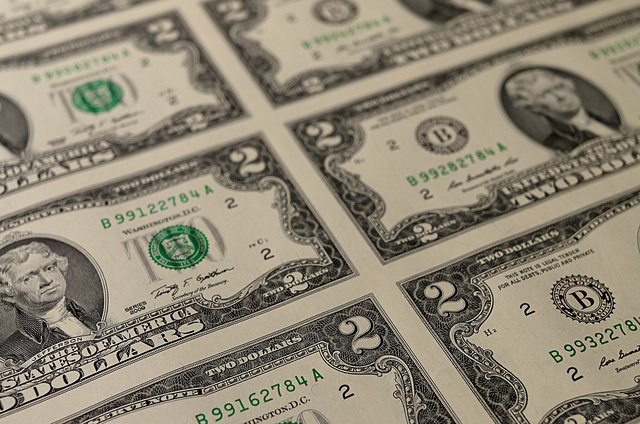Financial Crisis Anniversary: A Short History of QE
Happy Anniversary! Six years ago this week, the US financial system was brought to its knees. Over the course of seven days, Lehman Brothers filed for bankruptcy; Bank of America said it would buy Merrill Lynch; Goldman Sachs and Morgan Stanley became bank holding companies; the Federal Reserve bailed out insurance giant AIG; the Treasury Department had to insure money-market funds; and the government submitted its first draft legislation of TARP. Yeah, that all happened in one week! Two months after that momentous week, the economic downturn, which started in December 2007, accelerated. In an effort to create liquidity in the bond market and to help rescue the economy from plunging into the abyss, the Federal Reserve took the aggressive and unusual step of buying mortgage backed bonds, and eventually expanded the program to include government bonds.
As a reminder, here’s a short history of the central bank’s bond buying stimulus plan, known as “Quantitative Easing” or “QE”:
- November 2008: The first 15-month period of QE begins with purchases of mortgage securities, later expanded to include Treasury debt
- August 2010: Fed launches QE2 with a defined $600B target
- June 2011: Fed completes QE2
- September 2011: Fed announces “Operation Twist,” which allows the central bank to swap short term Treasuries for long-term ones
- September 2012: Fed launches QE3 and extends its intention to maintain low short-term interest rates until mid-2015
- December 2012: Fed announces that QE3 would be open-ended at $85B/month and that outright Treasury purchases would replace Operation Twist.
- June 2013: Fed Chair Bernanke announces that QE would wind down later in 2013 and would likely conclude by mid-2014, provided that the economy improves
- December 2013: Fed officials began the process of unwinding their bond-buying program by reducing purchases by $10 billion dollars to $75 billion
Six years later, the Fed strategy continues, but the central bank is in the process of unwinding the third version of that bond-buying program. The central bank will conduct a two-day policy meeting this week, where it is widely expected to announce another $10 billion cut, reducing monthly purchases to $15 billion. If you are doing your Fed math (or can subtract), you will quickly realize that QE3 will likely end at the October 29th meeting.
And just like that, the Fed will have undone its historic policy and will return to its more mundane tool of manipulating short-term interest rates to fight inflation.
Remember way back in March, when Janet Yellen made her first and now-famous snafu? She said that the central bank might start increasing short-term rates “six months” after the conclusion of QE3, which would put the first hike in April of next year. Investors freaked out and sold stocks and bonds, because that time horizon was sooner than previously projected.
Those who think rationally might think, “If the data show that the economy is improving and as a result, the Fed increases short term interest rates, isn’t that a good thing?” You might think so, but so much of the recovery stock market rally has been predicated on zero percent interest rates, which have made equities the most favored asset class.
So how will markets react to higher rates? According to Capital Economics, “The S&P 500 rose by an average of about 5 percent in the six months before the first rate hike in each of the last seven major tightening cycles [1971, 1976, 1984, 1986, 1994, 1999, 2004]…And it also gained an average of about 5 percent in the nine months after the first hike.”
That said, it’s hard to count on the rally continuing indefinitely and although nobody wants to say it, this time is different, since this rate hike cycle follows a once-in-a-generation financial meltdown and large-scale asset purchases by the Fed. Fasten your seat belts…it’s going to be a bumpy ride.
MARKETS: Stock indexes snapped a 5-week winning streak.
- DJIA: 16,987 down 0.9% on week, up 2.5% YTD
- S&P 500: 1985, down 1.1% on week, up 7.4% YTD
- NASDAQ: 4467, down 0.3% on week, up 9.4% YTD
- 10-Year Treasury yield: 2.61% (from 2.46% a week ago)
- October Crude Oil: $92.27, down 1% on the week
- December Gold: $1231.50, down 2.8% on the week
- AAA Nat'l average price for gallon of regular Gas: $3.40 (from $3.54 a year ago, lowest since Feb)
THE WEEK AHEAD:
Mon 9/15:
OECD releases its global economic outlook
8:30 Empire State Manufacturing
9:15 Industrial Production
Tues 9/16:
8:30 Producer Price Index
FOMC 2-day policy meeting begins
Weds 9/17:
8:30 Consumer Price Index
10:00 Housing Market Index
2:00 FOMC concludes/Fed economic projections
2:30 Fed Chair Yellen Press Conference
Thurs 9/18:
8:30 Weekly Jobless Claims
8:30 Housing Starts
10:00 Philadelphia Fed Survey
Alibaba prices its IPO – could be largest IPO in US history
Scotland votes on a referendum on independence, which would break up the 307-year-old U.K. and plunge Britain into a constitutional crisis. Voting concludes at 5:00pm ET
Fri 9/19:
Apple releases iPhone6
10:00 Regional/State Unemployment
Quadruple Witching: simultaneous expiration stock index futures, individual stock futures, stock index options and individual stock options
Sat 9/20
G-20 finance ministers and central bankers meet in Cairns, Australia

